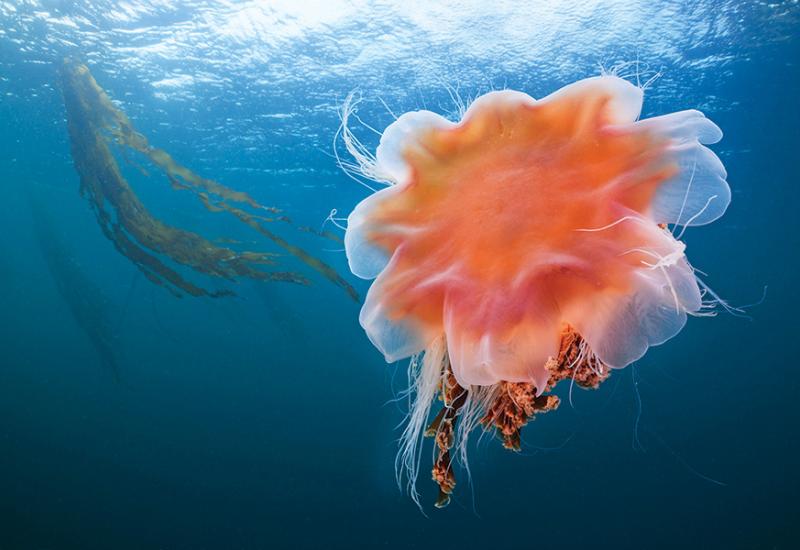Say Hello to Hells Bells, the World’s Largest Collection of Living Stalactites

Liquid Jungle MediaA diver floats above the halocline to take a close-up picture of the bells.
In Quintana Roo, an hour from Playa del Carmen and just a mile off the highway, the jungle becomes lush, dense and inaccessible on foot. But plunge 100 feet straight down into one of the region's many cenotes and the view changes quite a bit. Instead of riotous greenery, you’ll be staring at a spectral haze where the saltwater meets freshwater. Called the halocline, it’s high in salt, low in oxygen and impenetrable to most organic matter that falls into the cenotes. As leaves and everything else buried in the cenote decomposes, the sulfur released gets trapped in a water layer just above the halocline. This layer of hydrogen sulfide is poisonous to nearly all species, and few creatures can survive in the resulting noxious ecosystems.
Few well-known creatures, that is.
Zapote Cenote, more commonly known as Hells Bells, is one of the world’s most unique cenote dives. Once divers descend through the hourglass-shaped sinkhole, they approach the otherworldly sulfide layer about 100 feet down. That’s when they'll see something straight from the brush of Salvador Dali: enormous bell-shaped rock formations dangling like stalactites from the cenote's lower ceiling.
Only they're not quite stalactites, and they're not common. They’re alive and they’re very, very rare—and Hells Bells is home to the largest and most extensive display of such bells researchers have ever found.
"Vincente Fito [who first discovered the bells in 2011] took me to check the giant sloth skeleton (deeper in the cenote), and then we went to see the bells,” says Jerónimo Avilés Olguín Segovia, a researcher, speleologist and paleontologist who has authored many studies on Zapote. “And I was like, ‘these things are not regular stalactites!’”
"And it turns out I was correct," he adds.
Avilés had seen similar formations in 1999 in cenotes near Puerto Morelos. After seeing them again in Cenote Zapote, he formed a hypothesis: their growth wasn't a matter of sediment formations, like in a terrestrial cave, but tied to the bacteria trapped in the hydrogen sulfide layer. In a 2018 paper published in the Journal of Palaeogeography, Palaeoclimatology, Palaeoecology, Avilés, Dr. Wolfgang Stinnesbeck of Heidelberg University and several co-authors posited that the unique formations are the result of a "biogeochemical mechanism." It’s the bio part that makes the formations so unique.

Liquid Jungle MediaA diver makes their way past the unique formations.
Tiny creatures living in Hells Bells, known as "extremophiles" for their ability to thrive in extreme environments, get their energy from inorganic compounds, such as hydrogen sulfide. In processing the sulfur, they raise the pH level of the water, causing the unique formations to develop. Essentially, these unique little extremophiles change the chemical composition of the water just above the halocline, creating the very specific conditions needed for the bells to form.
What's even more interesting, however, is that the bells are alive—or their outer layer is, at least. In their research, Avilés and his coauthors found sulfur-powered organisms similar to those in the noxious layer covering the outside of all the bells, continually contributing to the calcium buildup. These biofilm-covered bells are found in a roughly 25-foot range, from around 90 to 115 feet deep. To researchers, this indicates the halocline level was once higher, perhaps during an extended flood, as the bells can only form very near to this layer.
Zapote isn't the only cenote where these bells form, but it's one of the few. Since the bells require a low-light environment, a thick hydrogen sulfide layer, and a nearly horizontal growing surface, there are only a few cenotes in the world where they've been found. Their distinctive "bell" shape, likely due to the cenote's hourglass shape, is found almost nowhere else on earth. In a 2020 article, researchers theorized that the bells are shaped that way because they formed around rising bubbles. When carbon dioxide bubbles rise, they get trapped against the almost horizontal ceiling. Once the formations develop a in circular shape, they continue to grow that way.
There may, however, be another similarly bizarre cenote on the map soon. "The good news is, we found them in another cenote from another state—but that is yet to be published,” Avilés teases.
What Avilés will share is his fascination with Zapote, which stems not just from the size and age of the formations, but the exceptional, preserved tree sitting below the halocline.

Liquid Jungle MediaThe bells' external layer is alive, coated in sulfur-powered organisms inhabiting that power their continue growth.
"My favorite thing about diving there is the amazing size of these formations—the biggest one so far measures four meters long by four meters wide: 'the big mama,'" he says. "But the very best is the drowned tree at the bottom of the cenote. It's 4,500 years old and is full of baby bells—the oldest is 200 years and the youngest only 30." It's those bells, Avilés says, that helped convince his colleagues the cenote was worthy of study.
Fortunately, divers can study the bells as well, provided they have an advanced open water certification, excellent buoyancy control and are comfortable in overhead environments—the bells are quite delicate. Dive shops like Koox Diving and CenoteXperience, both based in Playa del Carmen, usually take divers to another cenote before bringing them into Zapote. Fortunately, Hells Bells is on the "ruta de cenotes," close to other options like Kin Ha and Maravilla, both of which have a few clusters of 'mini-bells' just as unusual—albeit a touch smaller—than those in their deeper, more mysterious neighbor.










